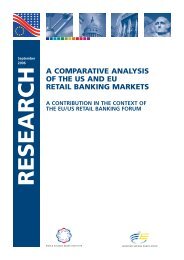Corporate Governance and Access to Finance - ESBG
Corporate Governance and Access to Finance - ESBG
Corporate Governance and Access to Finance - ESBG
Create successful ePaper yourself
Turn your PDF publications into a flip-book with our unique Google optimized e-Paper software.
The following indica<strong>to</strong>rs measure, in the Beck et al (2007) research, theuse of banking services, restricted <strong>to</strong> bank deposits <strong>and</strong> loans because ofdata availability:1. Loan accounts per capita: number of loans per 1,000 people.2. Loan–income ratio: average size of loans <strong>to</strong> GDP per capita.3. Deposit accounts per capita: number of deposits per 1,000 people.4. Deposit–income ratio: average size of deposits <strong>to</strong> GDP per capita.These are the indica<strong>to</strong>rs also used in a recent <strong>and</strong> influential report byCGAP (2009). The ratios applied <strong>to</strong> countries or large regions assume auniform distribution of bank outlets within a country <strong>and</strong> across itspopulation, while in most countries bank branches <strong>and</strong> ATMs areconcentrated in urban centers. Beck et al (2007) point out that thenumber of loans <strong>and</strong> deposit accounts is far from being a perfect proxyof the number of people that use these services in a country. Also, theaverage size of loans <strong>and</strong> deposits <strong>to</strong> GDP per capita might not berepresentative of the value of services that a typical individual mightreceive. Despite these shortcomings, their regression results show thatthese variables are positively associated with more households havingbank accounts. Honohan (2007) develops an index that tries <strong>to</strong> overcomethe usual problem of deposi<strong>to</strong>rs having several accounts in differentinstitutions. He estimates the fraction of the adult population that usesformal financial intermediaries. The estimates are constructed bycombining information on banking <strong>and</strong> MFI account numbers (<strong>to</strong>getherwith banking depth <strong>and</strong> GDP data) with estimates from householdsurveys for a smaller set of countries.Very few studies linking <strong>Corporate</strong> <strong>Governance</strong> practices <strong>and</strong> <strong>Access</strong> <strong>to</strong><strong>Finance</strong> can be used <strong>to</strong> establish the direct link between both. A potentialcausal relationship is even more difficult <strong>to</strong> ascertain. Mersl<strong>and</strong> <strong>and</strong> Strøm(2008b) compare two types of microfinance institutions with differentgovernance schemes due <strong>to</strong> their different ownership structures: nongovernment organizations (NGOs) <strong>and</strong> shareholder-owned firms.Their conclusions are that there are no differences in terms of length,breath <strong>and</strong> scope of operations between both types of MFI. In terms ofaccess <strong>to</strong> deposits, or the average loan, they show that NGOs are moresocially oriented than shareholder firms. Some unexplored mechanismslike competition seem <strong>to</strong> drive NGOs MFI <strong>to</strong> behave financially asshareholder MFI.110
















